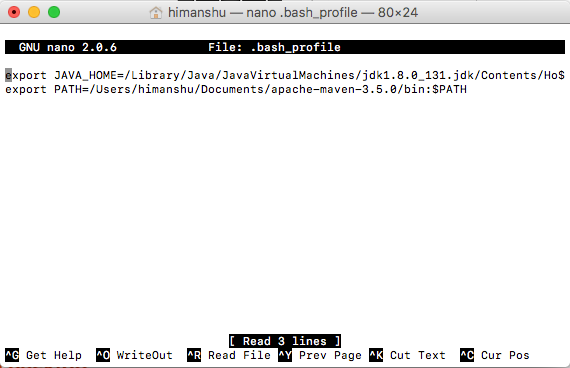

- #Mac os x apache execute how to
- #Mac os x apache execute mac os x
- #Mac os x apache execute mac os
- #Mac os x apache execute install
To do that, you may do the following:įire up Terminal and navigate to the default Document Root which is /Library/WebServer/Documents/ Let’s put a PHP File under the document root and see if Apache can execute that file. As Apache will be needing the php.ini file, we can simply copy from the existing, by typing:įrom here, we are now in the position to test out if Apache can execute some PHP Scripts served from the document root. That’s good for two reasons, we have something to copy, which makes life easier a little bit, and then in case something went wrong while we are tweaking the file, we have something to fallback to.

If your machine is like mine, you won’t be able to find php.ini in there, but instead, you’ll see the file. Now let’s check if there is that file already by looking it up with ls command: The php.ini file should be located in directory /private/etc/. But there is one more thing you have to do – make sure that you have a PHP configuration file called php.ini.
#Mac os x apache execute install
You don’t have to install PHP anymore since it is already there in your machine. If you are asked to confirm, just hit Y for YES. Save the changes by pressing Control + O. If you notice the pound sign (#) it means that line is commented out and therefore disabled. Locate the line that says "LoadModule php5_module libexec/apache2/libphp5.so" So from the command line, type the following then hit RETURN: For this example, we’ll use the nano text editor. Next edit the nf file with a text editor. Make a backup copy of the current Apache Configuration file by issuing these from the command line: Okay, follow along with me.įirst, be paranoid. You just need to tweak a single line from the Apache Configuration file, nf.

Configuring Apache 2 to use PHPĭoing this is very simple. But for now, let’s configure Apache so that it is able to serve PHP Scripts from the document root.
#Mac os x apache execute how to
Later in this article, you will learn how to create an Apache Virtual Host and map it into any directory that you wish to use.

The welcome message is contained in the file named. In Apache-speak, that’s called the DocumentRoot. In case you’re wondering where Apache is looking up the file to serve from the localhost, it’s located here: You can test it out to see if Apache is really running by firing up Safari or any Web Browser that you installed in you system and typing this in the address bar: You should be able to see a Welcome Message. Naturally, the sudo command will ask you for an administrative password, so go just type it in. You just need to run Apache to see it in action.
#Mac os x apache execute mac os
This one is pretty quick and easy since Apache 2 is really installed Mac OS X. So enough talk, let’s get going with the setup. And in fact, most commands that you issue against the database server are similar and compatible. Note that I picked MariaDB in favour of MySQL, but the two have a lot of things in common.
#Mac os x apache execute mac os x
This article shows you how to setup a PHP Web Development environment within Mac OS X (Mavericks) containing the following software components: Apache 2, PHP (of course), and MariaDB Server. So under the hood, I feel comfortable already. Here is a sampling of the things that comes pre-installed into a fresh Mac OS X: Python, Ruby, PHP, Apache and many more. It’s got most of the things I need for Web Development work. Strangely the above solution did not work till I appended ‘*’ to the directory path in httpd.Underneath its beautiful User Interface, Mac OS X is a power-house - it’s an operating system based on UNIX. I was working on a similar setup in Docker (Apache + Python), with one difference that the version of Apache was 2.4.25. Apparently it was not enough to set execute permission on individual script file – I had to provide execute permissions for the current folder (/Users/Ram/Sites), and all its parents till the Users folder (/User/Ram and /User).Īfter above changes the Python script executed successfully. The solution to fix this issue is described in the Apache Wiki . “Permission denied: access to /py/test.py denied (filesystem path ‘/Users/Ram/Sites’) because search permissions are missing on a component of the path” error. When I checked the error log (at /var/log/apache2) I saw – But instead I got “403 Forbidden You don’t have permission to access …” error. I then browsed to localhost/py/test.py and expected it to display “Apache-Python config working!”. I read somewhere that restart option does not work. I then restarted Apache – actually first stopped it (sudo apachectl stop) and then started again (sudo apachectl start). Set execute permission for this file (chomod +x test.py). #!/usr/bin/python print 'Content-Type: text/html \n\n ' print "Apache-Python config working!"


 0 kommentar(er)
0 kommentar(er)
